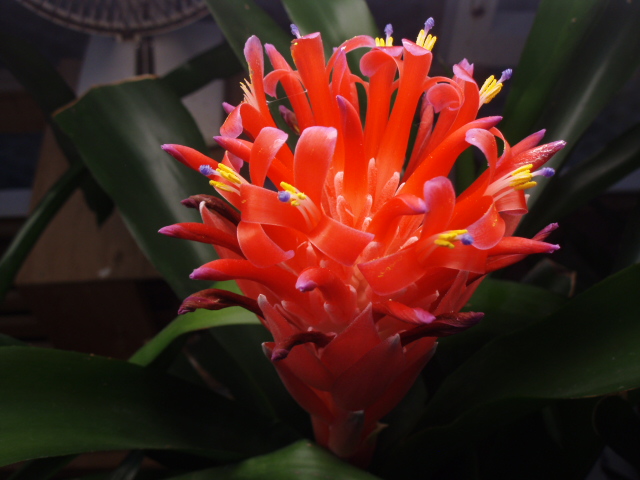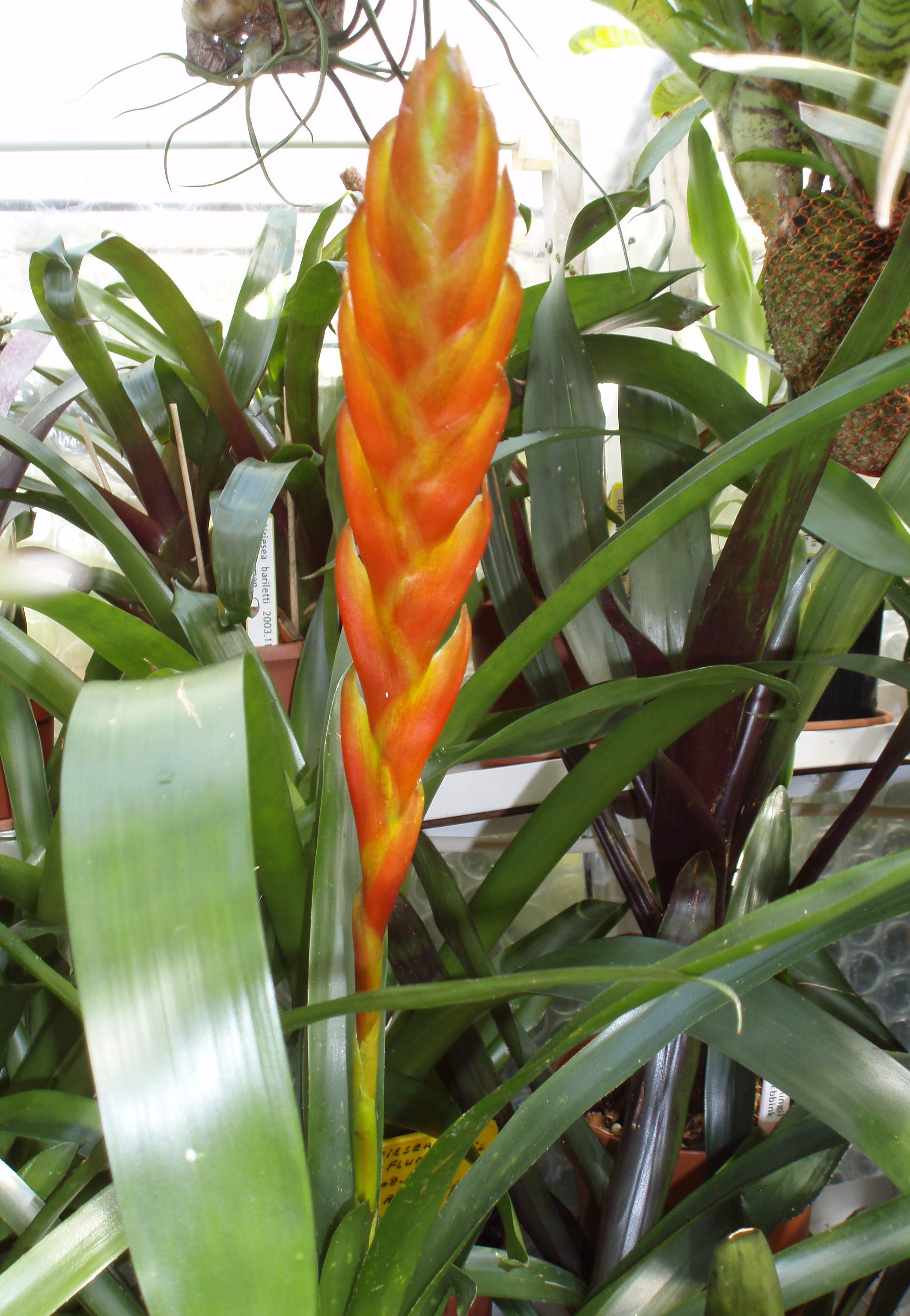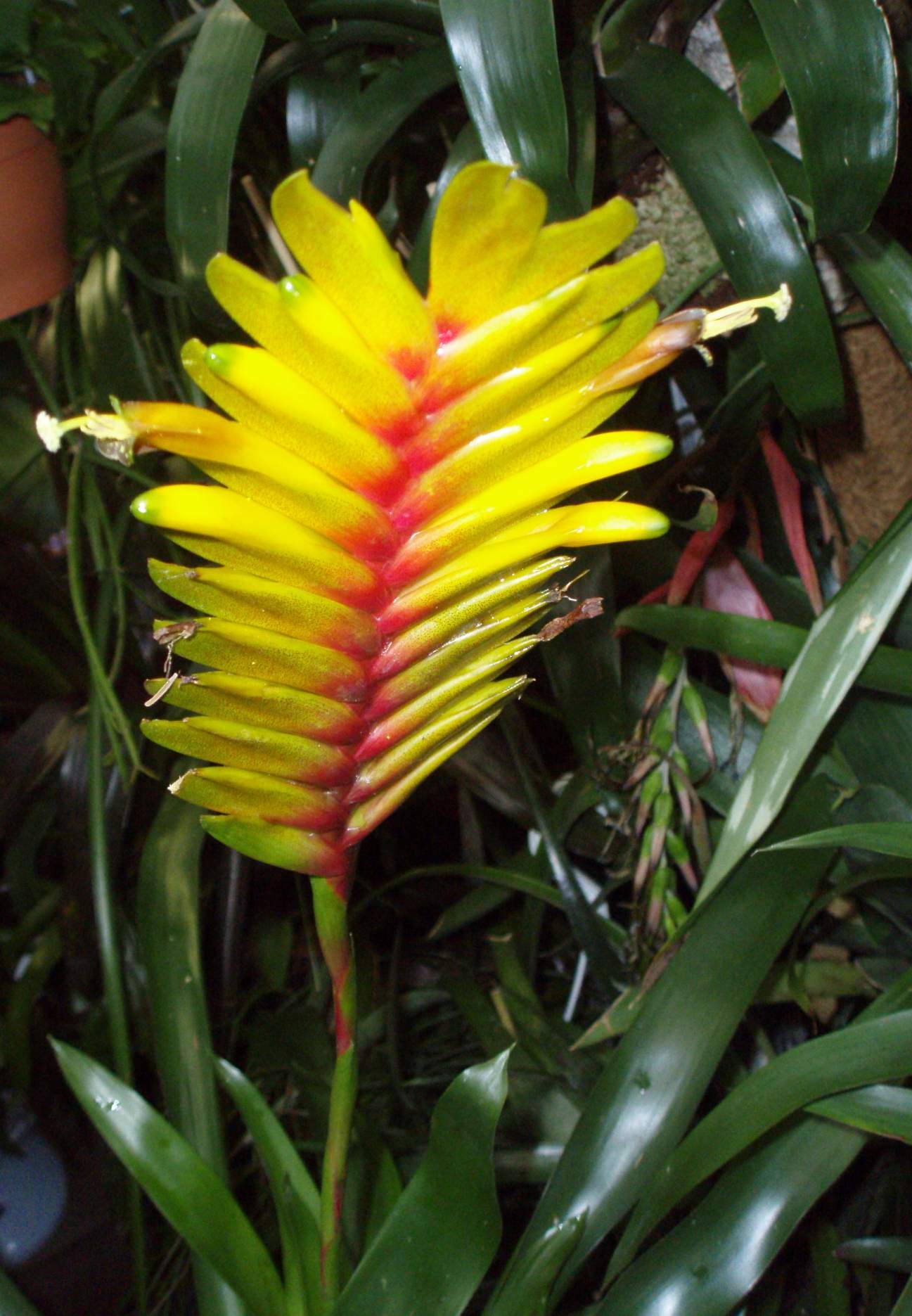 |
Bromelia Contactgroep (BCG) P/a Botanische Tuinen Budapestlaan 17 3584 CD Utrecht ABN-AMRO IBAN: NL66 ABNA0421855185 tel.030-253 9281 |
From Newsletter 81 - September 2015
Upcoming meeting
Dear bromeliad-lovers and BCG members,
We are happy to invite you all once again to our Autumn Meeting on Sunday October 11 2015 at the Utrecht Botanical Gardens in the conservatory near the back entrance at Harvardlaan 10. The coffee will be ready from 10am and you can greet one another, catch up, arrange and admire plants you and others have brought, consult the available literature and so on.
At 11am we shall be holding a house-keeping meeting. After this, there will as usual be a discussion of the plants people have brought and displayed. Don't be too embarrassed to bring a problem plant for advice. There is enough expertise present to provide some useful tips!

During lunch we shall raffle the plants members have brought and donated to the society for the purpose. Autumn is on its way and maybe you have trouble finding enough room to give all your plants a good place for the winter. So if you have too many plants and cuttings do please bring them to be raffled among your fellow hobbyists.
After the fun of the raffle, Piet van Beest, our treasurer, will take us on a trip through Belize and Guatemala and show us lots of bromeliads in their native habitats.
House-keeping meeting agenda
- 1. The Chairman's announcements and any mail received
- 2. The Treasurer's announcements
- 3. The minutes of the Spring Meeting of April 12 2015 (newsletter 80)
- 4. BCG excursions (see below). The members will be asked for their views about this.
- 5. Discussion and Other Business
We hope this will again result in an interesting and enjoyable get-together. Looking forward to October 11!
BCG excursions
There was sufficient interest in the visits we paid in previous years to the Hortus Botanicus in Leiden (twice), Blijdorp Zoo in Rotterdam, Plantentuin Meise in Belgium, Burgers Zoo in Arnhem and the Orchideeënhoeve in Luttelgeest. We enjoy the Botanical Garden in Utrecht at each of our meetings there. However, the number of Botanical Gardens in our country is somewhat limited. We cannot do anything for those with personal objections to (long) journeys. It would be ideal if we could organise a shared bus for an excursion but that would not be possible due to the geographical spread of our members.
Another, and to our mind, important aspect in organising a day out is that of creating opportunities for us all to get to know each other better as hobbyists, to make contacts, to share experiences, in short to make it an enjoyable day. Admittedly, our Spring and Autumn Meetings give similar opportunities but the excursions have additional advantages such as expert guides and entrance to collections that are normally closed to the public.
We look forward to discussing the question with you during the Autumn Meeting on October 11.
Best regards,
on behalf of the Board
Roel Tomassen: report & plant portraits
Eric Gouda: layout
Plant Portraits
Billbergia pyramidalis
 The bromeliad genus Bilbergia is characterised by striking inflorescences whereby in particular the bracts, which initially enclose the flowers, are coloured blood-red or a pretty shade of pink. Depending on the species, these inflorescences may be pendulous or stand upright. Sadly, we can only enjoy this beautiful colouration for a very short time (a few days at most). All the same, for many of us enthusiasts there is still a place for these Bilbergias, naturally mostly for the somewhat smaller species as this genus also houses some “whoppers”' that are more suited to the collections of Botanical Gardens. Bilbergia pyramidalis (fig. 1) is a medium-large species, still suitable for the windowsill! This year, once again, it surprised me by flowering. Suddenly a blood-red tip stuck up out of the tank and in a few days unfolded into a gorgeous inflorescence. In the meantime three fast-growing side shoots had already developed at the base of the plant. They can soon, once they have reached half the size of the mother plant, be cut off and potted up. That way you can have a flowering B. pyramidalis every year.
The bromeliad genus Bilbergia is characterised by striking inflorescences whereby in particular the bracts, which initially enclose the flowers, are coloured blood-red or a pretty shade of pink. Depending on the species, these inflorescences may be pendulous or stand upright. Sadly, we can only enjoy this beautiful colouration for a very short time (a few days at most). All the same, for many of us enthusiasts there is still a place for these Bilbergias, naturally mostly for the somewhat smaller species as this genus also houses some “whoppers”' that are more suited to the collections of Botanical Gardens. Bilbergia pyramidalis (fig. 1) is a medium-large species, still suitable for the windowsill! This year, once again, it surprised me by flowering. Suddenly a blood-red tip stuck up out of the tank and in a few days unfolded into a gorgeous inflorescence. In the meantime three fast-growing side shoots had already developed at the base of the plant. They can soon, once they have reached half the size of the mother plant, be cut off and potted up. That way you can have a flowering B. pyramidalis every year.Not got this species yet? Do your best to get it!
Vriesea incurvata
If at first you don't succeed ...! A couple of years ago during a family visit in Vienna I was able to visit the Botanische Garten there. As planned, Dr W. Till guided me and my wife Carla round the greenhouse complex and did we enjoy it! And I think Dr. Till also thought “aan een boom zo vol geladen mist men vijf, zes pruimen niet” (with a tree so fully laden no-one will miss five or six plums) and generously gave us a number of cuttings. “Do you know this species?” he would ask. “No, you haven't got one?” and “snip” said the secateurs! So a few days after this delightful morning a dozen or so cuttings went in our hand luggage on the aircraft back to Heerhugowaard. One of them was Vriesea incurvata (fig. 2), a well-known species but not one that I already had. Well, there are so many varieties aren't there? Where all the other cuttings started growing easily I had no success with V. incurvata. Now I am pretty good at getting healthy bromeliad cuttings to grow but this cutting was, so to say, damned if it would. What to do now? Every couple of months take it out of the pot and … still no roots! After repeating this three or four times I told it (I talk to my plants!). “It's your problem” and I put it away among other plants. Sometimes I compare them to small children who get grumpy. You probably know all about it. Everything and everyone is “NO!!”. And that cross face with it too! It nearly always sorts itself out as long as you don't try to change the child's mind since that always has the opposite effect! So if the same thing happens to you as happened to me with the Vriesea incurvata … don't say anything, leave it alone with its grumpiness, pretend you're daft or deaf. My plant kept its filthy mood going for a long time, for about a year and a half. I really do congratulate myself for not throwing it out in the meantime. And then … all at once … it was there and when I saw it creep out from among the other plants I asked “So, you've changed your mind have you?”. Yes, it nodded!! Six months later it flowered, that was this spring.
Where all the other cuttings started growing easily I had no success with V. incurvata. Now I am pretty good at getting healthy bromeliad cuttings to grow but this cutting was, so to say, damned if it would. What to do now? Every couple of months take it out of the pot and … still no roots! After repeating this three or four times I told it (I talk to my plants!). “It's your problem” and I put it away among other plants. Sometimes I compare them to small children who get grumpy. You probably know all about it. Everything and everyone is “NO!!”. And that cross face with it too! It nearly always sorts itself out as long as you don't try to change the child's mind since that always has the opposite effect! So if the same thing happens to you as happened to me with the Vriesea incurvata … don't say anything, leave it alone with its grumpiness, pretend you're daft or deaf. My plant kept its filthy mood going for a long time, for about a year and a half. I really do congratulate myself for not throwing it out in the meantime. And then … all at once … it was there and when I saw it creep out from among the other plants I asked “So, you've changed your mind have you?”. Yes, it nodded!! Six months later it flowered, that was this spring.What a recalcitrant child!
Vriesea x Mariae
Translation: MaryRose Hoare
